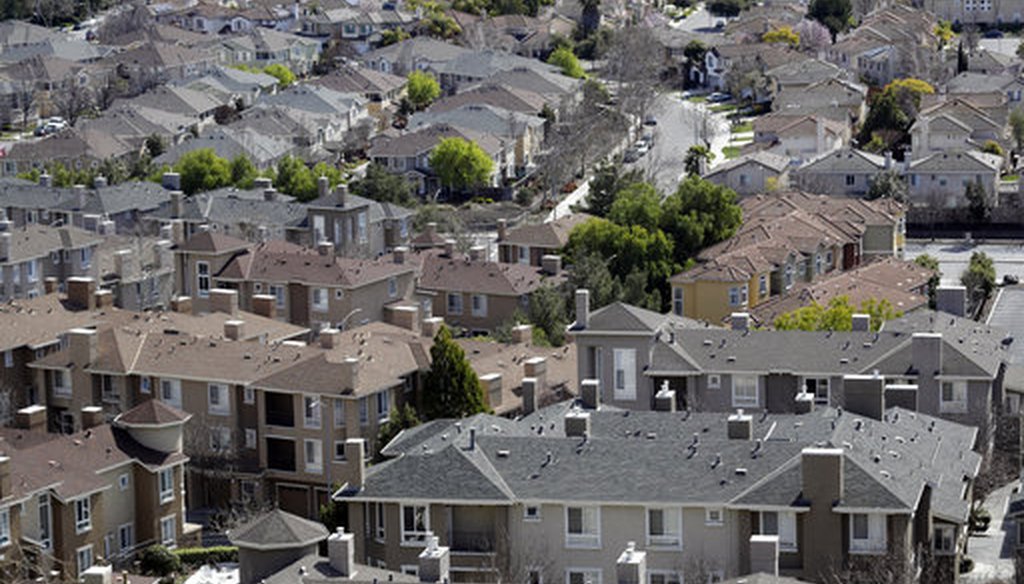

Our only agenda is to publish the truth so you can be an informed participant in democracy.
We need your help.


Homes stack up in a neighborhood in San Jose, Calif., amid rising incomes. (AP/Marcio Jose Sanchez)
Politicians often point to the success of America’s middle class as a barometer for the health of the broader American economy.
On Sept. 29, the West Virginia Republican Party tweeted, "Thanks to President Trump and Republican policies, middle-class income rose to a record level in 2017 as the strong economy lifted the fortunes of more Americans, the U.S. Census reported Wednesday! #WVGOP"
Is this accurate? We will give context for the party’s claim of credit for the Trump administration, but our fact-check is looking solely at the numbers.
"Middle class" is a vague term that does not have a consistent definition. However, economists generally consider median income to be a reasonable yardstick for the "middle class."
According to an annual study published by the U.S. Census Bureau in September 2018, the U.S. median income was $61,372 in 2017, a 1.8 percent increase from the previous year after adjusting for inflation.
The new level of $61,372 represents a record high since the statistic has been recorded, although the inflation-adjusted figure has come close a few times in the past, census data shows. In 1999, for instance, inflation-adjusted median household income reached $60,062, and in 2007, shortly before the Great Recession, it reached $59,534.
Less certain is the assertion that the record median income level is "thanks to President Trump."
As we have frequently noted, economists say that presidents don’t deserve either full credit or full blame for employment trends on their watch. The president is not all-powerful on economic matters; broader factors, from the business cycle to changes in technology to demographic shifts, play major roles.
"I suppose President Trump could claim that the upward trend in per capita or median income between 2016 and 2017 was due the policies that his new administration adopted or pursued, in deregulation, taxation, immigration, and trade," said Gary Burtless, an economist at the Brookings Institution. However, he said, "that is not terribly compelling, because incomes had been improving for several years before Mr. Trump took office."
Indeed, between the beginning of the post-Great Recession recovery in 2010 and 2016 -- a period when President Barack Obama was exclusively in office -- inflation-adjusted median income rose by about 9 percent. Taking into account the longer period of time, that’s a little slower than 1.8 percent annual increase under Trump, but it’s not dramatically different.
So the bump in median income under Trump is largely similar to the trajectory under Obama, rather than representing a major turnaround. That undercuts the argument for crediting Trump exclusively.
The West Virginia Republican Party said that "middle-class income rose to a record level in 2017 as the strong economy lifted the fortunes of more Americans."
According to the U.S. Census Bureau, median household income did rise to a record high in 2017 of $61,372.
The party is on far less certain ground when it credits Trump, who, like any president, deserves some -- but hardly all -- credit for the economy’s performance on his watch.
Looking solely at the numbers, though, the statement is accurate. We rate it True.
West Virginia Republican Party, tweet, Sept. 12, 2018
Washington Post, "Middle-class income rose above $61,000 for the first time last year, U.S. Census Bureau says," Sept. 12, 2018
U.S. Census Bureau, historical household income tables, accessed Nov. 1, 2018
U.S. Census Bureau, "Income, Poverty and Health Insurance Coverage in the United States: 2017" and tables, Sept. 12, 2018
Email interview with Gary Burtless, senior fellow at the Brookings Institution, Nov. 5, 2018
In a world of wild talk and fake news, help us stand up for the facts.
